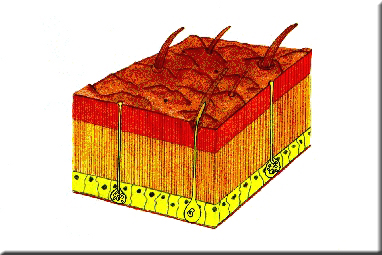|
****JavaScript
web menu drop down DHTML menu generated by NavStudio. (OpenCube Inc.
- http://www.opencube.com)****
|
||||
|
|
Insect Hyperdiversity Insects ( "Size, metamorphism and wings" are the design features which have helped to contribute to the enormous success of insects as a group, according to [Southwood 1978] .
Insects are extremely adaptable, and are tolerant of a huge range
of environmental conditions, allowing them to occupy virtually every |
|||
 Exoskeleton |
Exoskeleton The cuticle is lightweight, tough and waterproof, and is constructed from layers of protein and chitin. It acts as an exoskeleton, which must be moulted to allow growth. |
|||
 Body form and colour |
Body Form and Colour The insect body form is adaptable to many different forms, enabling insects to adapt to living in numerous habitats and exploiting many niches. The insect cuticle is adaptable to numerous colours, enabling insects to camouflage themselves, to mimic more dangerous or foul-tasting species, and to distract predators. |
|||
 |
Insect Food and Mouth Parts Insect mouth parts are adapted to allow feeding on a vast range of About 15 % are parasitic on other insects.
|
|||
|
Bug Mouth Parts Bugs (Order Hemiptera) are piercing and sucking liquid-feeders, on sap or blood. Mandibles and maxillae are elongated into a piercing tube, and the labium forms a supporting sheath. Key to the mouth parts of a generalised and specialised insect: orange = labrum; green = mandibles; purple = maxillae; red = labium. |
||||
|
Mantid Mouth Parts Preying mantids are voracious predators. They use their powerful mandibles to chew their prey. |
||||
|
Fly Mouth Parts Many flies (Order Diptera) are lapping feeders, with a sponge-like labium, and a sucking tube formed by the labrum and hypopharynx.Mandibles are lost; only the sensory palps remain of the maxillae. Key to the mouth parts of a generalised and specialised insect: orange = labrum; green = mandibles; purple = maxillae; red = labium. |
||||
|
Butterfly Mouth Parts Butterflies are liquid-feeders, probing for nectar and sipping other organic liquids. Their long, coiling and uncoiling proboscis is formed from part of the paired maxillae. The labrum is tiny; the mandibles have gone; and the labium consists of mostly palps. Key to the mouth parts of a generalised and specialised insect: orange = labrum; green = mandibles; purple = maxillae; red = labium. |
||||
